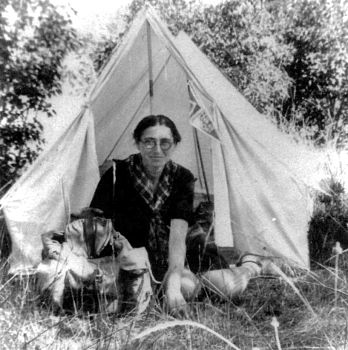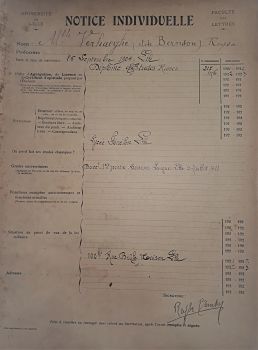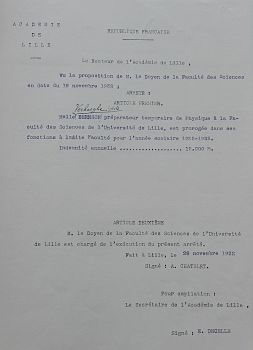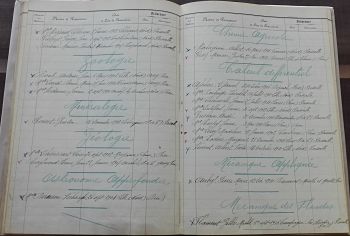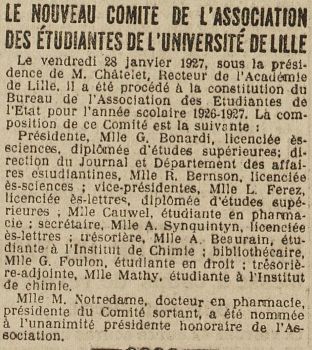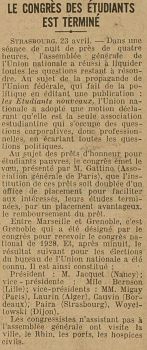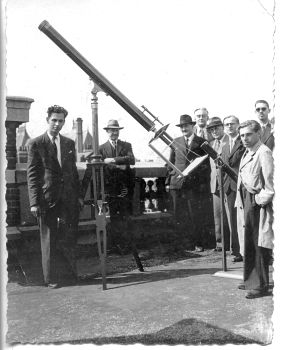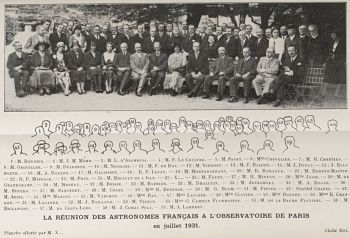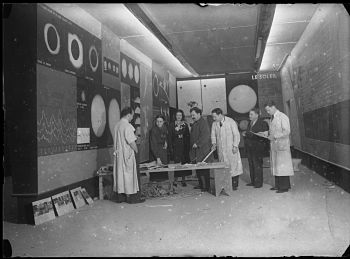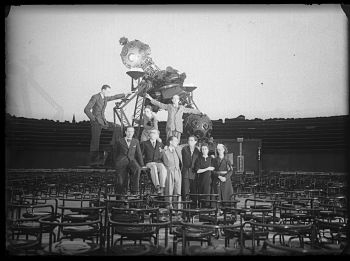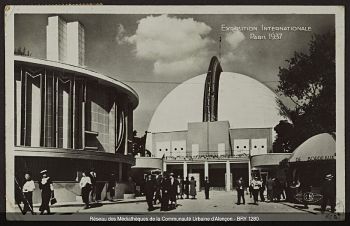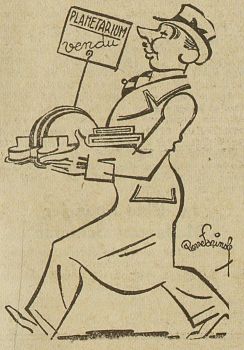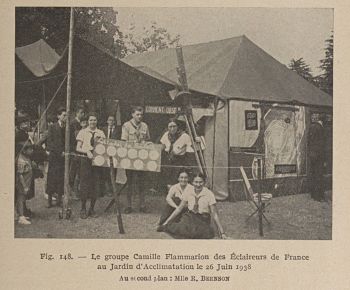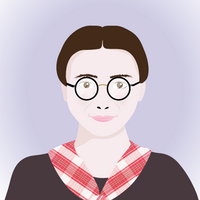
Les Petits Bonhommes for which her parents paid a subscription in 1912. Thistypo3/#_ftn1youth publication, created the previous year by the Ligue ouvrière de protection de l’enfance (Worker’s League for the Protection of Children), perfectly reflected the values espoused by Désiré Verhaeghe and Dweira Bernson[1]. Reysa Verhaeghe’s parents separated, but never divorced, probably after the Great War. From this time on, the young woman seemed to prefer to use her mother’s surname rather than her birth name.
A brilliant, dedicated student
Reysa Bernson completed her secondary education at the Lycée Fénelon in Lille, graduating in 1921 with the first part of her baccalauréat in Sciences and Languages. That same year, she passed the first-year exam for the diploma in Russian studies at the Lille Faculty of Arts with honours.The following year, she obtained her baccalauréat at the Faculty of Science. At the same time as studying science and Russian, she took music theory classes with the Union Française de la Jeunesse (French Youth Union). A particularly brilliant student, Reysa Bernson finished her Russian studies in 1923, passing the final exam. In 1924, she received her Bachelor of Science degree. That same year and the ones that followed, she validated certificates of higher education in astronomy, general chemistry and radiotelegraphy. She went on to obtain a post-graduate degree in 1927 and a degree in advanced astronomy in 1934. In January 1926, she won first prize (ex-aequo) in the English language competition, higher education section, which was organised by the Société Industrielle du Nord (Nord Industrial Society.
Strongly involved in student life, in 1925 Reysa Bernson took part in the revival of the publication of the Annals of the Lille Student Association. The following year, she was one of Lille’s delegates to the 15th Congress of the Union Nationale des Étudiants de France (National Union of French Students) in Poitiers.
In 1927, as a member of the executive board of the Association des Étudiantes de l’État de Lille (Lille State Students’ Association) in charge of managing the newspaper Lille-Étudiante and student affairs, she became treasurer of the newly formed Union des Associations d’Étudiants et d’Étudiantes de l’Université de Lille (Union of Student Associations of the University ofLille)[2]. A few days later, on 23 April, she was elected vice-president of the Union Nationale des Étudiants (National Students Union) at the Strasbourg congress, the only woman on the board.
L’Égalité de Roubaix-Tourcoing decided to do a series of articles based around the topic ‘What are you going to do with your children?’, journalist Fred went to meet her to talk about the case of young girls. However, the journalist couldn’t help expressing commonly held sexist prejudices at that time:‘Mums, what are you going to do with your daughters? I went to ask Miss Reysa Bernson, who may never be a mother because all she cares about is career guidance, physics and astronomy. Her apartment, located at 219 c, boulevard de la Liberté in Lille, is a real curiosity, reflecting the originality of its occupant: [...]. Never had the even the most basic of beauty products touched the lips, cheeks or eyelashes of the severe face of this ‘miss’, who sported tortoiseshell glasses and long hair tied up in bands and braids’.
Passing on a taste for astronomy
Passionate about astronomy, Reysa Bernson was admitted as a member of the French Astronomical Society at the age of 16, at the society’s meeting on 5 May 1920. She was sponsored by Camille Flammarion, the society’s founder, and Maurice Ballot, its librarian. Four years later, at the age of 20, Reysa Bernson founded the Nord Astronomical Association. She explained the genesis of her project in the magazine L’Astronomie in 1925: ‘It was during a short stay in Paris, at the end of December 1922, that I came up with the idea of creating an Astronomical Society in Lille. When I visited the French Astronomical Society, I realised how much amateurs could benefit from a shared observatory and library, when few could have done it alone. My first idea had been to bring together the existing enthusiasts in Lille, but this idea soon changed and, in addition to working with other insiders, I started to bring the subject to a wider audience; that’s when I knew I had to do something official. The inaugural meeting of the Nord Astronomical Association took place on 20 December 1923 at the Nord Industrial Society, in the presence of the rector of the Lille education authority, Albert Châtelet, who himself helped found the association. The association was registered with the prefecture on 14 February 1924, and was based at the Lille Institute of Physics, 50 rue Gauthier-de-Chatillon. Professor Georges Bruhat, Director of the Institute of Physics, made the Institute’s terrace, a room and a photographic laboratory available to the association. In its first year of existence, the Nord Astronomical Association already had 140 members, two telescopes, a newsletter and offered regular classes and lectures.
typo3/#_ftn1Guette[3] she received individually and the Commemorative Medal[4] she received as part of the Planetarium team, which she directed, at the 1937 Paris International Exhibition. While Reysa Bernson was very much involved in astronomy, her activity increased tenfold from 1929 onwards, both within and outside of the Nord Astronomical Association. She was interested in passing on astronomical knowledge, and increased her activities to raise awareness of the subject whenever the opportunity arose. In particular, she was commissioned by the rectors of the Lille and Strasbourg education authorities to give lectures in primary and secondary schools. From December 1932 onwards, following an agreement between the Nord Astronomical Association and the Nord Radiophonytypo3/#_ftn3Association[5], she offered monthly talks for the general public, including Radio PTTtypo3/#_ftn4Nord’s ‘Quart d’heure radio-astronomique’[6]. During this period, she travelled to Germany and Poland, satisfying her passion for astronomy, making contacts and sharing her discoveries.
lecturers[7]. On 29 October 1937, Reysa Bernson, the venue’s general secretary, had the privilege of counting French President Albert Lebrun among the spectators. Despite its uniqueness in France, its strong educational appeal and the mobilisation of a number of key figures, the Planetarium was dismantled the following year.
Animated Astronomy Diagrams, which was designed to meet school curriculum expectations, at the 6th Scientific Cinema Congress in Paris. For several years now, Reysa Bernson had split her time between Lille and Paris, as required by her activities. On 2 June 1940, just a few days before the arrival of German troops in Paris, Reysa Bernson joined other members of the French Astronomical Society who had come, as they did every year, to the park of the Juvisy-sur-Orge Observatory to pay their respects at the tomb of Camille Flammarion. Reysa Bernson, who had been such an active figure, disappears from the sources during the Occupation. We only know that she deposited objects at the Paris Observatory and that she moved to the Nord Astronomical Association in 1943. There was no further trace of her until 1944, when she was arrested in Dreux on 23 February along with her mother Dweira Bernson. The reason for their arrest was their Jewish origin. Taken to the Chartres prison, they were transferred the next day to the Drancy camp. Convoy 69 left Drancy for Auschwitz on 7 March 1944. Their family’s efforts to save them came too late. Her cousin, Madeleine Malengé-Dorchies, and her husband, Émile, were unable to send Désiré Verhaeghe’s baptismal certificates in time. She and her mother Dweira never returned from Auschwitz. A committed, brilliant and tireless promoter of astronomy, it took over 70 years for the City of Lille to pay tribute to her by naming an alley in the Saint-Maurice – Pellevoisin district after her.
Notes written by Nathalie Barré-Lemaire.
Notes
[1] See Dweira Bernson-Verhaeghe’s biography.
[2] L’Union des associations d’étudiants et d’étudiantes de l’Université de Lille was the amalgamation of two associations: l’Union des Étudiants de l’État, which was founded in 1881, and l’Association Générale des Étudiantes, which was founded in 1910 and reserved for female students.
[3] Known since 1956 as the Prix Georges Bidault de l’Isle, this prize is awarded to young people who attend classes and lectures regularly, have collaborated at the observatory or carried out personal work communicated to the French Astronomical Society or published in the magazine L’Astronomie in the year preceding the award of the prize.
[4] The Commemorative Medal of the French Astronomical Society is awarded to a member who has attracted a large number of members.
[5] The rapprochement between the two associations was probably facilitated by Georges Thibault, an industrialist from Haubourdin, member of the board of the Nord Astronomical Association and member of the committee of the Radiophony Association
[6] The following year, at the request of the Radiophony Association, the Nord Astronomical Association was obliged to put forward another speaker for the ‘Quart d’heure radio-astronomique’. The 22 June 1903 issue of the newspaper Le Grand Écho du Nord de la France,which mentions this fact, does not specify the reason.
[7] In addition to Reysa Bernson, the Planetarium’s general secretary, Auguste Budry, Jacques Codry-Lepage, Armand Delsemme, Eliézer Fournier, André Hamon, Henri Kannapell and Gérard Oriano took it in turns to address visitors for 14 hours a day.
Bibliography
Danielle Delmaire and Jean-Michel Faidit, ‘Vie et mort de deux femmes juives. In the shadow of a husband and father’, Tsafon [Online], 74 | 2017, published online 31 May 2018, accessed 14 November 2019. URL: journals.openedition.org/tsafon/405; DOI: 10.4000/tsafon.405
Sources
Nord Department Archives
Lille Faculty of Arts student file - 2640W767.
Lille Faculty of Science graduate register - 3268W83, 3268W84.
Lille Faculty of Science personnel file - 3631W20.
File relating to the arrest of Dweira and Reysa Bernson, 1944 - 1W1879.
Nord Astronomical Association / Jonckheere Association
Photograph of Reysa Berson, date unknown.
Photograph of the roof of the Lille Institute of Physics, date unknown.
Photograph of the ‘Le Soleil’ exhibition at the Paris International Exposition, 1937.
Photograph of the Planetarium at the Paris International Exhibition, 1937.
Ciel Nord,bulletin of Nord Astronomical Society, no. 78, 1994.
gallica.bnf.fr/National Library of France
Digitised press and magazines: Le Grand Écho du Nord de la France, L’Œuvre, Excelsior, L’Astronomie, Les PetitsBonhommes.
bn-r.fr / Bn-R - Roubaix Digital Library
Digitised press: L’Égalité de Roubaix-Tourcoing, Le Journal deRoubaix.
The author gratefully acknowledges the help of Danielle Delmaire, Jean-Michel Faidit, Alain Vienne and André Amossé.

